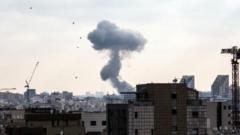**Details emerge from a meticulously planned airstrike on Iran's nuclear capabilities, with reports of severe damage to key sites.**
**Pentagon Launches Covert Operation Against Iranian Nuclear Facilities**

**Pentagon Launches Covert Operation Against Iranian Nuclear Facilities**
**Operation Midnight Hammer Marks a Significant U.S. Military Action**
In a highly classified military operation dubbed “Operation Midnight Hammer,” the Pentagon has successfully targeted and struck Iranian nuclear facilities in a show of American military prowess. Defense Secretary Pete Hegseth and Gen. Dan Caine, the chairman of the Joint Chiefs of Staff, detailed the intricacies of the operation during a press briefing at the Pentagon on Sunday.
The targeted strikes occurred between 6:40 p.m. and 7:05 p.m. Eastern Time and involved the use of B-2 stealth bombers and submarine-launched cruise missiles on three significant Iranian nuclear sites: Fordo, Natanz, and Isfahan. Mr. Hegseth asserted that the sites had been “obliterated,” a statement closely aligned with President Trump's earlier remarks. While comprehensive damage assessments are still pending, preliminary reports indicate substantial devastation across all three sites.
The operation commenced from Whiteman Air Force Base in Missouri and required strategic aerial refueling over a staggering distance of more than 7,000 miles. The bombers executed their mission with precision, successfully navigating through a complex flight path that crossed both the Atlantic and Mediterranean seas before reaching Iranian airspace.
General Caine acknowledged the heightened interest in the operation's battle damage assessment, emphasizing the meticulous planning and execution that went into the mission. As the Pentagon remains tight-lipped on whether Iran retains its nuclear weapon-making capabilities, the military's recent action marks a pivotal moment in U.S.-Iran relations and underscores the ongoing tension surrounding Iran's nuclear ambitions.
The operation's results could reshape future military strategies as the U.S. continues to assert dominance in regional security and counter-nuclear proliferation efforts.
The targeted strikes occurred between 6:40 p.m. and 7:05 p.m. Eastern Time and involved the use of B-2 stealth bombers and submarine-launched cruise missiles on three significant Iranian nuclear sites: Fordo, Natanz, and Isfahan. Mr. Hegseth asserted that the sites had been “obliterated,” a statement closely aligned with President Trump's earlier remarks. While comprehensive damage assessments are still pending, preliminary reports indicate substantial devastation across all three sites.
The operation commenced from Whiteman Air Force Base in Missouri and required strategic aerial refueling over a staggering distance of more than 7,000 miles. The bombers executed their mission with precision, successfully navigating through a complex flight path that crossed both the Atlantic and Mediterranean seas before reaching Iranian airspace.
General Caine acknowledged the heightened interest in the operation's battle damage assessment, emphasizing the meticulous planning and execution that went into the mission. As the Pentagon remains tight-lipped on whether Iran retains its nuclear weapon-making capabilities, the military's recent action marks a pivotal moment in U.S.-Iran relations and underscores the ongoing tension surrounding Iran's nuclear ambitions.
The operation's results could reshape future military strategies as the U.S. continues to assert dominance in regional security and counter-nuclear proliferation efforts.























